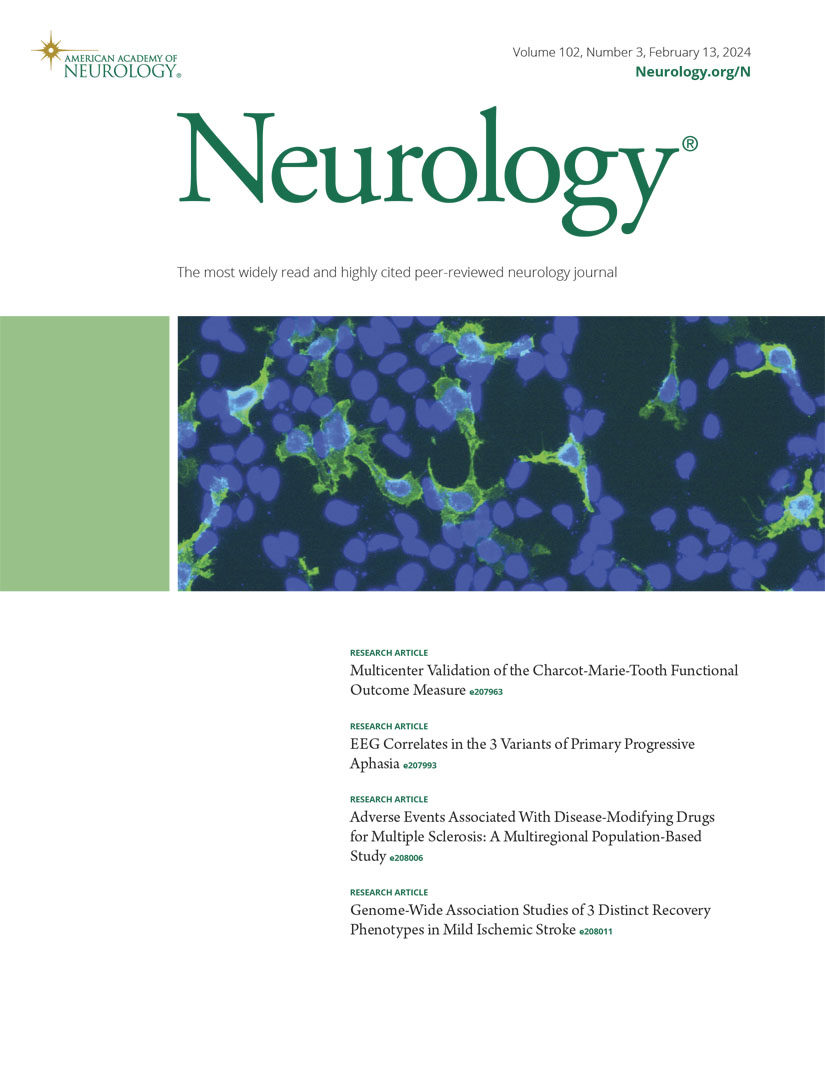Frequency, Risk Factors, and Outcomes of Strokes in Patients With Primary Glioma After Cranial Radiation Therapy.
IF 7.7
1区 医学
Q1 CLINICAL NEUROLOGY
引用次数: 0
Abstract
BACKGROUND AND OBJECTIVES Radiation therapy is the mainstay of therapy for patients with glioma. While this treatment modality can improve survival, treatment-related complications may include radiation-induced vasculopathy and increased risk of stroke. We aimed to evaluate the stroke frequency, associated risk factors, and outcomes after cranial radiation therapy in patients with glioma. METHODS This is a retrospective cohort study at a single tertiary academic brain tumor center involving patients diagnosed with gliomas between 2005 and 2021 who received cranial radiation therapy. Data were collected from the time of cranial radiation therapy until last follow-up. Logistic regression analyses were used to evaluate the association of clinical and demographic variables with all-cause, ischemic, and hemorrhagic strokes. RESULTS In a retrospective cohort of 930 patients, 910 received radiation therapy (mean age 53.8 years; 40% women) and were included in the final analysis. A total of 91 patients (10.0%) were diagnosed with stroke (73.6% ischemic; 15.4% with recurrent strokes). The median time to diagnosis of stroke after onset of radiation therapy was 652 days with median time to recurrent stroke of 102 days. In a univariable model, Black race (odds ratio [OR] 3.83, 95% CI 1.94-7.56), radiation necrosis (OR 4.62, 95% CI 2.02-10.55), hypertension (OR 1.93, 95% CI 1.23-3.01), hyperlipidemia (OR 5.93, 95% CI 3.61-9.57), and diabetes mellitus (OR 2.25, 95% CI 1.28-3.95) were associated with higher odds of all-cause stroke. In multivariable analysis, Black race (OR 3.41, 95% CI 1.59-7.33), radiation necrosis (OR 6.42, 95% CI 2.45-16.79), and hyperlipidemia (OR 6.42, 95% CI 3.91-10.57) were significantly associated with increased odds of all-cause stroke. Radiation necrosis and hyperlipidemia were associated with increased odds of ischemic stroke. Black race, hyperlipidemia, and younger age were associated with increased odds of hemorrhagic stroke. Compared with ischemic strokes, hemorrhagic strokes were associated with higher poststroke disability. DISCUSSION In a large, retrospective cohort of adult patients with glioma treated with cranial radiation therapy, 1 in 10 patients were subsequently diagnosed with stroke with 15.4% suffering recurrent strokes. Factors associated with increased odds of stroke included Black race, radiation necrosis, and hyperlipidemia and should be validated in future prospective cohorts. Study limitations include the retrospective design, incomplete stroke workups, and lack of molecular diagnostics.脑放射治疗后原发性胶质瘤患者卒中的发生频率、危险因素和预后。
背景与目的放射治疗是神经胶质瘤患者的主要治疗方法。虽然这种治疗方式可以提高生存率,但治疗相关的并发症可能包括辐射诱导的血管病变和卒中风险增加。我们的目的是评估脑胶质瘤患者脑卒中频率、相关危险因素和颅脑放疗后的预后。方法:这是一项回顾性队列研究,涉及2005年至2021年间接受颅脑放射治疗的脑胶质瘤患者。数据收集自颅脑放射治疗至最后一次随访。Logistic回归分析用于评估临床和人口统计学变量与全因、缺血性和出血性中风的关系。结果:在930例患者的回顾性队列中,910例患者接受了放射治疗(平均年龄53.8岁;40%为女性),并被纳入最终分析。共有91例(10.0%)患者被诊断为卒中(缺血性卒中73.6%;15.4%为复发性卒中)。放射治疗后到卒中诊断的中位时间为652天,到卒中复发的中位时间为102天。在单变量模型中,黑人(比值比[OR] 3.83, 95% CI 1.94-7.56)、放射性坏死(OR 4.62, 95% CI 2.02-10.55)、高血压(OR 1.93, 95% CI 1.23-3.01)、高脂血症(OR 5.93, 95% CI 3.61-9.57)和糖尿病(OR 2.25, 95% CI 1.28-3.95)与全因卒中的高发生率相关。在多变量分析中,黑人(OR 3.41, 95% CI 1.59-7.33)、放射性坏死(OR 6.42, 95% CI 2.45-16.79)和高脂血症(OR 6.42, 95% CI 3.91-10.57)与全因卒中的发生率增加显著相关。放射性坏死和高脂血症与缺血性中风的几率增加有关。黑人、高脂血症和年轻与出血性中风的几率增加有关。与缺血性中风相比,出血性中风与较高的卒中后残疾相关。在一项大型回顾性队列研究中,有1 / 10的成年胶质瘤患者接受了颅脑放射治疗,随后被诊断为卒中,15.4%的患者复发性卒中。与卒中风险增加相关的因素包括黑人、放射性坏死和高脂血症,这些因素应在未来的前瞻性队列中得到验证。研究的局限性包括回顾性设计、不完整的卒中检查和缺乏分子诊断。
本文章由计算机程序翻译,如有差异,请以英文原文为准。
求助全文
约1分钟内获得全文
求助全文
来源期刊

Neurology
医学-临床神经学
CiteScore
12.20
自引率
4.00%
发文量
1973
审稿时长
2-3 weeks
期刊介绍:
Neurology, the official journal of the American Academy of Neurology, aspires to be the premier peer-reviewed journal for clinical neurology research. Its mission is to publish exceptional peer-reviewed original research articles, editorials, and reviews to improve patient care, education, clinical research, and professionalism in neurology.
As the leading clinical neurology journal worldwide, Neurology targets physicians specializing in nervous system diseases and conditions. It aims to advance the field by presenting new basic and clinical research that influences neurological practice. The journal is a leading source of cutting-edge, peer-reviewed information for the neurology community worldwide. Editorial content includes Research, Clinical/Scientific Notes, Views, Historical Neurology, NeuroImages, Humanities, Letters, and position papers from the American Academy of Neurology. The online version is considered the definitive version, encompassing all available content.
Neurology is indexed in prestigious databases such as MEDLINE/PubMed, Embase, Scopus, Biological Abstracts®, PsycINFO®, Current Contents®, Web of Science®, CrossRef, and Google Scholar.
 求助内容:
求助内容: 应助结果提醒方式:
应助结果提醒方式:


